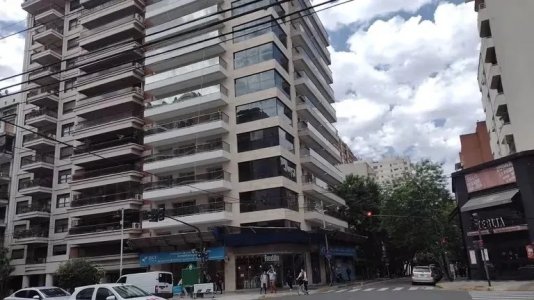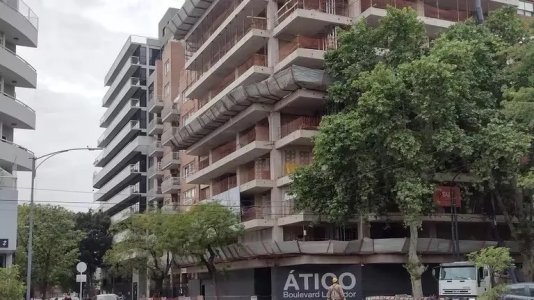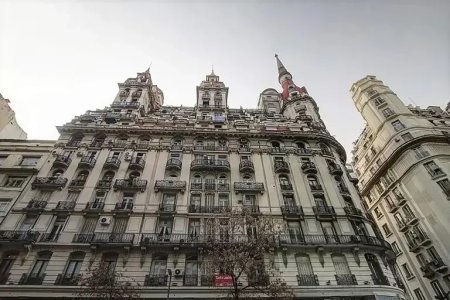BuySellBA
Administrator
Urban Code and New Constructions in CABA
November 17, 2023
Urban Code and new constructions in CABA: What are the changes being analyzed and why Buenos Aires avenues will be key
The Buenos Aires Urban Development Secretariat, together with neighborhood representatives and private builders, is working on a project that will be presented to the legislature in 2024, including significant changes to the building code.

Crossing of Avenida Cramer and Echeverría in the Belgrano neighborhood, an area with several projects in progress on corners. They seek to apply modifications to the Urban Code in the way of building for the coming years.
The Urban Planning Code (CUR) regulates the use and construction of land in the city of Buenos Aires and since 2019 it has enabled greater possibilities on small plots and reduced construction on large plots. The movement generated and the execution of more than 50,000 homes at this time generated complaints from neighborhood organizations and now the Buenos Aires Urban Development Secretariat, more private builders and representatives of neighborhood organizations are working on the development of a project to apply some regulatory reforms that must deal with the Legislature in 2024.
Next December, a new Head of the Buenos Aires Government, Jorge Macri , takes office . The work to reform the CUR must be undertaken the same because modifying the code coincides with the four years established by law. Sources from the Urban Development Secretariat, headed today by Álvaro García Resta (in a few days it will be confirmed whether he will continue to lead the organization), explained to Infobae that they are in the process of collecting opinions from neighbors, associations, advisors of the urban environmental plan and institutions.
Currently, the project is being prepared that will be presented to the legislature in the first days of December, where its approval and possible modifications by Buenos Aires legislators will be determined next year.
“When the CUR was sanctioned, a review was contemplated every four years. During that period, neighborhood associations pointed out tensions with the norm in some neighborhoods. In response, the Buenos Aires Government prepared preliminary proposals to address these problems. Currently, work is being done on the implementation of a new scheme,” Gonzalo Bustos , from the consulting firm FOT Libre, informed Infobae.
The current reality is that meetings are underway to present the project to the legislature. Bustos explained: “The draft was presented by the Secretariat of Urban Development before the Permanent Participatory Forum, marking the first stage of the modification process as established by law. The next steps to follow are: 1) Participatory Process; 2) Public Hearing; and 3) Double reading in the Legislature.”
The possible changes under analysis contemplate the possibility of reducing the height allowed within neighborhoods compared to current regulations, in addition to considering the implementation of staggered heights in blocks with medium or high-level corridors, particularly in avenues.

Another corner project, in this case between Avenida San Isidro Labrador and Correa, in Saavedra
Neighbors and the Government propose prohibiting new constructions, allowing them only on avenues or dense neighborhoods such as Recoleta, Caballito, Palermo, Belgrano and Caballito. However, development is limited by unfavorable environmental conditions and the need for large-scale buildings to be viable.
Architect Alan Schachter , real estate consultant and urban code expert, told Infobae that “increasing buildable capacity on avenues favors extremely large, high-quality constructions that can mitigate environmental conditions unfavorable for life. A relevant fact is that, of all the works registered since the entry into force of the CUR (2019-2023), less than 10% began construction.”
Most of the City has buildings of up to two floors, covering all of the plots (78% throughout CABA), with back gardens being rare. In 1977, low areas were established that allowed construction on a large part of the plots. In 2018, the reform did not alter this dynamic, similar to the high conflict observed in 2004-2007 due to construction expansion.
“In both periods, criticism focused on height, and currently, concern falls on buildable depth. The proposal does not advocate recognizing blocks with consolidated green areas, but rather rezoning the entire city in low areas with a format of luxury houses, sustainable only in specific areas such as Belgrano R and Villa Devoto,” Schachter explained.
It is considered to modify Sustainability Unit (USAB) 1, with a Low Height with a maximum of 9 meters, and USAB 2, with a maximum height of 11.60 meters. Currently, the buildable area is restricted by the Internal Basement Line (LIB).
Bustos added: “The project contemplates extending this area to the Internal Front Line (LFI), which implies an occupation of a smaller surface area. It is proposed that the plots be occupied up to the LFI instead of reaching the LIB.”

Bencich Building, where the writer Alfonsina Storni lived for a time, on Córdoba Avenue. The aim is to protect more than 4,000 properties of heritage value in the city, preventing their demolition or the loss of their historic facades.
It is planned to grant legal protection to properties classified preventively, affecting 4,200 lots, considering them of heritage value.
Of the 135,000 century-old buildings, around 20,000 have heritage value, with only 3,000 already under legal protection. A catalog includes others, currently protected but susceptible to lack of protection by administrative act. If approved, they would obtain irreversible legal protection, requiring another law to reverse it.
https://buysellba.com/news-/-media/f/urban-code-and-new-constructions-in-caba
www.buysellba.com
November 17, 2023
Urban Code and new constructions in CABA: What are the changes being analyzed and why Buenos Aires avenues will be key
The Buenos Aires Urban Development Secretariat, together with neighborhood representatives and private builders, is working on a project that will be presented to the legislature in 2024, including significant changes to the building code.

Crossing of Avenida Cramer and Echeverría in the Belgrano neighborhood, an area with several projects in progress on corners. They seek to apply modifications to the Urban Code in the way of building for the coming years.
The Urban Planning Code (CUR) regulates the use and construction of land in the city of Buenos Aires and since 2019 it has enabled greater possibilities on small plots and reduced construction on large plots. The movement generated and the execution of more than 50,000 homes at this time generated complaints from neighborhood organizations and now the Buenos Aires Urban Development Secretariat, more private builders and representatives of neighborhood organizations are working on the development of a project to apply some regulatory reforms that must deal with the Legislature in 2024.
Next December, a new Head of the Buenos Aires Government, Jorge Macri , takes office . The work to reform the CUR must be undertaken the same because modifying the code coincides with the four years established by law. Sources from the Urban Development Secretariat, headed today by Álvaro García Resta (in a few days it will be confirmed whether he will continue to lead the organization), explained to Infobae that they are in the process of collecting opinions from neighbors, associations, advisors of the urban environmental plan and institutions.
Currently, the project is being prepared that will be presented to the legislature in the first days of December, where its approval and possible modifications by Buenos Aires legislators will be determined next year.
“When the CUR was sanctioned, a review was contemplated every four years. During that period, neighborhood associations pointed out tensions with the norm in some neighborhoods. In response, the Buenos Aires Government prepared preliminary proposals to address these problems. Currently, work is being done on the implementation of a new scheme,” Gonzalo Bustos , from the consulting firm FOT Libre, informed Infobae.
What are the changes being studied?
From the sector, they indicate that neighborhood organizations, in collaboration with legislators, promoted rezonings that violated participatory processes by being led by a small group of neighbors without interaction with other actors. In the last two years, proposals were presented in five neighborhoods: Palermo, Chacarita, Villa Devoto, Villa del Parque and Villa Santa Rita, without the required participatory debate. Neither the Buenos Aires Government nor this select group of neighbors held this debate.The current reality is that meetings are underway to present the project to the legislature. Bustos explained: “The draft was presented by the Secretariat of Urban Development before the Permanent Participatory Forum, marking the first stage of the modification process as established by law. The next steps to follow are: 1) Participatory Process; 2) Public Hearing; and 3) Double reading in the Legislature.”
The possible changes under analysis contemplate the possibility of reducing the height allowed within neighborhoods compared to current regulations, in addition to considering the implementation of staggered heights in blocks with medium or high-level corridors, particularly in avenues.

Another corner project, in this case between Avenida San Isidro Labrador and Correa, in Saavedra
Neighbors and the Government propose prohibiting new constructions, allowing them only on avenues or dense neighborhoods such as Recoleta, Caballito, Palermo, Belgrano and Caballito. However, development is limited by unfavorable environmental conditions and the need for large-scale buildings to be viable.
Architect Alan Schachter , real estate consultant and urban code expert, told Infobae that “increasing buildable capacity on avenues favors extremely large, high-quality constructions that can mitigate environmental conditions unfavorable for life. A relevant fact is that, of all the works registered since the entry into force of the CUR (2019-2023), less than 10% began construction.”
Most of the City has buildings of up to two floors, covering all of the plots (78% throughout CABA), with back gardens being rare. In 1977, low areas were established that allowed construction on a large part of the plots. In 2018, the reform did not alter this dynamic, similar to the high conflict observed in 2004-2007 due to construction expansion.
Some buildings currently under construction were already under construction before the code went into effect, including more than 1,000 on different corners
“In both periods, criticism focused on height, and currently, concern falls on buildable depth. The proposal does not advocate recognizing blocks with consolidated green areas, but rather rezoning the entire city in low areas with a format of luxury houses, sustainable only in specific areas such as Belgrano R and Villa Devoto,” Schachter explained.
It is considered to modify Sustainability Unit (USAB) 1, with a Low Height with a maximum of 9 meters, and USAB 2, with a maximum height of 11.60 meters. Currently, the buildable area is restricted by the Internal Basement Line (LIB).
Bustos added: “The project contemplates extending this area to the Internal Front Line (LFI), which implies an occupation of a smaller surface area. It is proposed that the plots be occupied up to the LFI instead of reaching the LIB.”

Bencich Building, where the writer Alfonsina Storni lived for a time, on Córdoba Avenue. The aim is to protect more than 4,000 properties of heritage value in the city, preventing their demolition or the loss of their historic facades.
It is planned to grant legal protection to properties classified preventively, affecting 4,200 lots, considering them of heritage value.
Of the 135,000 century-old buildings, around 20,000 have heritage value, with only 3,000 already under legal protection. A catalog includes others, currently protected but susceptible to lack of protection by administrative act. If approved, they would obtain irreversible legal protection, requiring another law to reverse it.
https://buysellba.com/news-/-media/f/urban-code-and-new-constructions-in-caba
www.buysellba.com
Last edited:

